Truffle Hunting!
On our trip to Italy in 2017 we paid to go on a truffle hunting excursion. It was a bust! Climate change had delivered several years of drought which is anathema to truffles. To boot the Italian truffle hunter spoke barely any English at all and knew there would be no truffles to find. We were bummed about the experience, to say the least.
Fast forward to our trip to France where Lisa did some great research a while back and found many reviews of a truffle farm experience near Roussillon where we were staying. Based on the reviews we decided to give truffle hunting another try. So on our first full day in France we set off to Les Patras Farm to meet Johann, the owner. We weren’t sure what to expect, but were hoping for a better experience than in Italy. We were not disappointed!
But first, do you know about truffles?
In a nutshell, a truffle is a fungus that grows underground in the close vicinity of oak trees. Because it is the “fruiting body” of a fungus it is still considered to be a mushroom even though it grows beneath the soil. They are hard to find, come with different levels of quality and are considered a delicacy the world over, which is why a pound of top-quality truffles can cost upwards of $3,000!
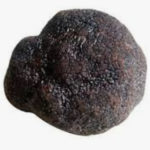
As you can see from the photo above, they aren’t much to look at. Let’s face it, an individual truffle looks a lot like a small dog turd. And if you’ve never had a truffle, you’re probably wondering what the hell is so great about them. Trust me, they are friggin’ delicious, although the flavor of a truffle is only half of the attraction, the other half is the magnificent aroma they give off and infuse throughout everything you put them in. This is why you see truffle products like salts and oils in stores everywhere these days. (More on this later).
Truffles come in two colors, black and white. Johann, our truffle farmer guide told us not to make a big deal out of the color. No one apparently seems to know why some truffles turn white. They just do. Although white truffles can have an intense aroma, more than a black truffle supposedly, the smell fades much faster than a black truffle. This makes black truffles of greater interest and value, generally.
Johann surprised me with the depth of his knowledge about truffles and his willingness, joy even, in sharing his expertise with us during our visit.
In fact, there is much scientists and farmers are still learning about truffles which is why farming truffles is a big investment of money, blood, sweat and tears. Truffles don’t just “appear”. To farm truffles you need oak trees that have been embedded with truffle spores in the roots. Yep, there’s a market for them. I think Johann said a small truffle impregnated oak sapling can cost around 25 euros. Not much, right, for a future of truffle harvests? Well, you need to remember that the tree has to grow for up to 10 years before it produces any truffles! While it’s growing, it has to be watered just right. Too little moisture and you get nothing (like Italy), too much and you get nothing. Too hot? Nothing. Too cold? Nothing. In the end, after 10 years some trees will produce truffles and others won’t, often for no immediately discernible reason. It’s a hard way to make a living!
Because they grow underground, farmers over the centuries (ancient Egyptians used to eat them, too) have used animals to hunt for them. From the beginning until recent history, pigs were used to find truffles. Why? Because pigs absolutely love truffles!
How does a pig hunt for truffles? The pig uses it’s extremely keen sense of smell to locate them under the soil and then roots them out of the ground with its nose. The problem with using domesticated pigs to find truffles is that they love them and unless deterred by their owner/handler, they will gobble the choice little morsels right up before they can be harvested. So farmers who used pigs had to be very quick to capture the truffle before the pig ate it. Johann told us that you can usually spot old truffle farmers in France. How? They are often missing a couple of fingertips! Like I said, pigs love truffles! LOL!
So farmers needed a solution – man’s best friend to the rescue! Yes, they started training dogs to hunt truffles! Now dogs, of course, are not pigs and could care less about truffles. They’d much prefer a chew toy or a steak to a truffle any day. So dogs have to be trained to hunt for them. This is done just as you might imagine, using a reward system. Find a truffle? Get a reward. No truffle? No reward. Dogs work just as hard trying to find the little buggers, but for them it’s all about the treat they get if they are successful. And the farmers don’t lose any digits trying to get the truffle. Cool! Any dog can be trained to find truffles, which is why so many mutts are used.
Some lessons learned:
Although a truffle may look like a hard little turd, a good truffle will have moisture. You can squeeze it and it will give. When they dry out they lose their aroma. This is an important thing to remember.
I mentioned above how quickly the aroma of a truffle can disappear when comparing black and white truffles and I want to emphasize something we learned from Johann. Good quality truffles have a longer-lasting aroma. How long? Between 4- 6 months. Think about that. Lisa and I didn’t know if we should laugh or cry when we heard this because we have a container each of truffle salt and oil at home that are at least a year old, probably older.
Johann emphasized that if you buy anything with truffle in it, do NOT let it languish! Use it while it’s fresh!
Now you may have truffle products at home that are aging and still seem to keep their aroma. Johann told us that in most cases this is because “flavors” have been added to the oil, salt, whatever. He told us to check the ingredients and avoid flavorings unless we don’t care. Johann was very proud to claim that his products last longer than any store-bought truffle products and he told us the reason is his organic method of farming. This could be a yarn he’s telling us, but we tasted his products and they were amazing!
Another lesson – whereas black truffles tend to hold their aroma longer than white truffles, not all black truffles are alike. The king of truffles is the black “winter truffle.” That’s right, truffles are different when grown in summer vs winter, with winter producing the very best quality truffles. Johann walked us through a taste test and made believers out of all of us.
So, when buying truffles, look at the freshness date on the container, remembering the 4-6 month disappearing act for the fragrance. Look to see whether “flavors” have been added. If at all possible, find out if the truffles they use are winter truffles. The next time you go to a specialty store and see truffle oils and salts, etc., remember that many of these products are potential bullshit.
Below are some photos of our visit to the truffle farm.
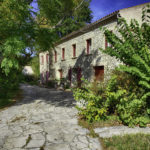
Les Patras was quite an idyllic setting, nestled into a Provence hillside.
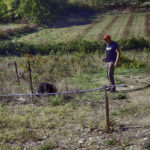
The dogs were quite remarkable to watch (see above). They were all love and hugs and petting before work, but while working we couldn’t interact with them at all. They needed to stay focused!
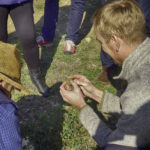
We each got a chance to get up close and personal with a truffle.
You’d think we were digging for gold we got so excited. In a way, I guess we were digging for some black gold!
After touring the farm and the truffle hunt, we went inside where we were treated to a truffle tasting that completely blew our minds!
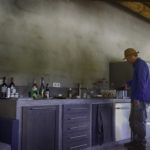
When Lisa booked the farm she emailed Johann and told him about our dismal Italian truffle hunt and also impressed on him that we never got to even taste any truffles there and that she hoped this experience would be better. Johann exceeded our expectations!
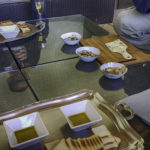
Yes, the photo above does indeed show several bowls full of black truffle slices!
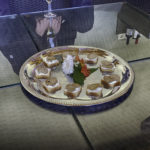
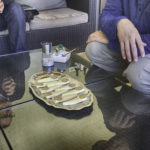
We tried all of his products, except truffle wine, which he was out of. We walked away with a purchase of truffle salt and oil. We intend to use these products while they are fresh. Later in our trip we sampled and purchased some wonderful truffle cheese at the Isle sur la Sorgue market made with winter truffles. Our heads exploded! I can hardly wait to open it up!
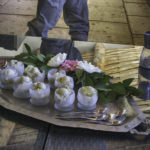
We finished off our sampling with truffle ice cream, drizzled with truffle honey and truffle shaving! What an experience!
My next post will cover our visit to the monastery asylum where Vincent van Goh spent some time as he went slowly crazy, as well as an interesting experience at a place called Carrieres de Lumieres and a few more photos of Roussillon.